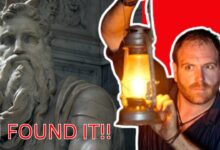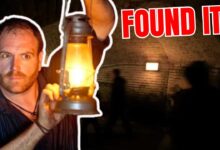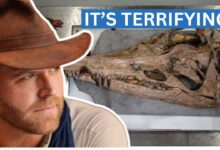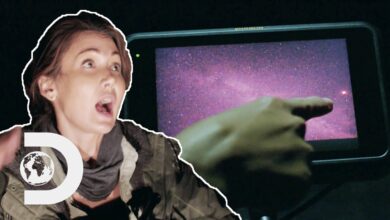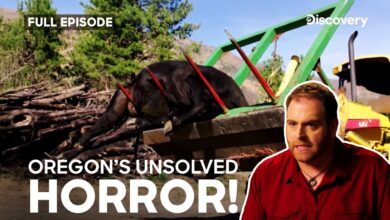Finding the Location of Missing First Transatlantic Flight! | Expedition Unknown
Finding the Location of Missing First Transatlantic Flight! | Expedition Unknown

In 1927, Charles Lindbergh becomes the first person to fly from New York to Paris non-stop in the Spirit of St. Louis. His feat turns him into a global icon and charts a course for America’s dominance in commercial air travel. But history and the future were almost very different.
Just two weeks before Lindbergh’s historic flight, French pilot Charles and navigator François Kholi attempted the crossing in the opposite direction aboard a plane known as the Lusso Blanc or the White Bird. Thousands gathered to watch their triumphant landing in front of the Statue of Liberty—except the plane never arrived. It vanishes without a trace.
One of the largest search and rescue operations in history comes up empty-handed. It was assumed that the White Bird never made it across the Atlantic. But now, newly discovered evidence suggests that it may have reached North America. One expert is targeting the wilderness of Newfoundland, where a fragment of metal could prove the plane broke apart in a remote pond.
With fog rolling in, bad weather in the forecast, and no roads to Gull Pond, this is going to be interesting. Let’s do it. Here we go.
The trip takes us over some of the most remote terrain on Earth: an endless expanse of rocks, bogs, and ponds.
“Yeah, once you get outside the city, it’s just wilderness. It’s incredible. We got caribou over here at three o’clock. Get that!”
“Wow.”
“We’re coming up on Redhead. These cliffs right here. We are now in the exact place where Dobbins saw this airplane for the last time. Point last seen right here.”
“We’re doing about 100-110 knots, which is just what the White Bird would have been doing. They’re coming in this hot, no landing gear, no wheels.”
“That’s right. I mean, I can totally understand now and put myself in this position of desperately looking for a place to land.”
“Josh, this is Goldpine. This is it. This is the place. And this is for sure the largest body of water I’ve seen out here. This is a place you could try to put a plane down for sure.”
“And where’s that island?”
“Right over here.”
“So all those stories and the metal you found from that little island?”
“Yep.”
“Okay, now we just gotta find a place to land.”
The helicopter drops us off to meet Rick’s team, who have already choppered in: magnetic imaging experts and drone operators Kiavish Parvor and Andrew Ganyan, Nandram, and airplane archaeologist Lisa Daly.
“Okay, let’s talk about this beast right here. This is a drone.”
“Yeah, right here we have a commercial multicopter drone. That we use for geophysical surveys.”
“On the aircraft’s engine?”
“We’re hoping to detect the probably the only thing that’s left of the White Bird, because the airplane was wood and fabric, and it blew up and burned. The hypothesis we’re testing is that the airplane came in from the East, attempted to land on the pond, and struck this rocky island.”
“I’m going to press go, and it’s going to follow its GPS track and start surveying.”
“Mowing the lawn.”
“Exactly. Alright, mow away. Let’s do it.”
The drone lifts off and begins its pre-programmed grid over the pond, flying 100 feet in the air to cover almost 100 acres of territory in a fraction of the time it would take from the ground.
“So how long is it going to take to scan this whole pond?”
“The whole lake will take about three to four hours to fly.”
“Alright, so we got some time on our hands.”
A few hours later, the drone has landed, and the data is in.
“I’m excited to see if we’ve bagged the White Bird.”
“Walk us through the color patterning first.”
“So, blue would be low magnetic intensity, and the reds into the purples and the pinks are the higher end. So, the bedrock here does have a lot of magnetic signal. So, what we’re looking for here is a few of the smaller outliers that sort of don’t fit the pattern, we can’t really explain based on the geology.”
“And did you find targets like that?”
“Yes. We have four or five suspicious targets that I cannot explain geologically, like this one, kind of like a butterfly thing.”
“As you can see, right?”
“And that is not what geology does in this area.”
“Can you show us where we are in relation to the island?”
“Yeah, the island is here, and the anomaly that we just saw is over here. So that’s why I’m a little bit more suspicious on that.”
“Second target is going to be this one, so it’s this here, right near the island?”
“Yes.”
“Okay, so something there that may not be natural.”
Exactly. The scan has revealed several promising targets that could support the theory that the White Bird crashed onto the small rocky island in the middle of Gull Pond. Now we just need to get a closer look. If there are answers, that’s where they are.
Our targets? We’re gonna need boats. The good news is we brought some with us. The bad news: some assembly is required.
“Use the hand or foot-operated air pump to inflate the boat. Inflation must be done by a trained geologist.”
“It’s a good thing we’re here then.”
“Just trying to get out of it. Fill each chamber until it is stiff to the touch but not hard.”
“Moving on.”
“Got it, Rick. I got it.”
“Meet the white boat.”
“There’s really no good place to bring this ashore, so let’s really slowly try to walk it in here. Watch out for these sharp rocks.”
“Hey Rick, I’m going to start scanning over here and work my way around to you.”
It shouldn’t take long to cover an island this small, but the terrain turns a simple task into an arduous affair.
“I mean, it’s so rocky here with so many little nooks. Who knows? There could be debris anywhere out here.”
“Nothing out here, Rick. You got anything in there?”
“No.”
“I’m going to head a little further out. Maybe we get lucky out here.”
“Hey, Josh, I got a hit over here.”
“Okay. What do you got?”
“Good news is, I’ve got a strong hit. The bad news is, it’s under a giant rock.”
“Yeah, look at this. Let it rock.”
“Oh yeah.”
“I got it. Something there.”
“Okay. Alright, let’s think about this for a second. Rock doesn’t grow, no.”
“And we’re not getting any return off the rocks. It’s not like we’ve got hot rocks out here.”
“So it’s got to be a piece of metal that got under that rock somehow.”
“Hold this way.”
“You’re going to pick up the rock? I thought that’s strong, you’re Josh Gates, come on.”
“But I may be able to reach down a little bit.”
“Yeah, come on, what is this?”
“Oh, I got something.”
“Oh, hi! I just felt something sharp.”
“I got something.”
“What is that?”
“I don’t know.”
“Fishing hook?”
“I don’t think that is a fishing hook.”
“No, it’s not. You sure?”
“No, it’s not.”
“It’s a piece of wire. Is it safety wire?”
“Safety wire is used to this day in order to lock fasteners in place where vibration can cause them to loosen or fall out. For example, in a biplane in 1927.”
“I don’t know what that is, but that’s fascinating that it’s here. I mean, it’s not a piece of fishing tackle.”
“I don’t know if I broke it on the end or if there’s anything else down there.”
“Well, there is more.”
“Oh, there is more.”
“There’s more. It’s something sharp here. I just don’t know if it’s a rock.”
Trying to free it, we’ve been so busy digging in the rocks, we failed to notice some important big-picture details, as I learned when my producer Dave calls on the radio.
“What’s going on, Dave?”
“We got weather. It’s coming in right this second. We need to leave or it’s coming in sooner than expected.”
“We’ll be picking up. Let’s have the helicopter take a first load of people out, and we’ll start making our way back to shore.”
“I’m going to give this two more minutes, then I’m getting out of here.”
Suddenly, we’re in a race against time. The last thing we want is to be trapped on this tiny island when a thunderstorm hits. But I can’t bring myself to leave for just a few more seconds.
“I got something! Oh, I got something else! Hold on!”
“I got something else. Hold on.”
“I don’t know. Can lid? What do you think?”
“No, it’s not a can lid. It’s way too heavy.”
“Let’s keep that underwater because if we expose it to air, it will deteriorate.”
“So, we put it in a bag of water. As much as it looks like a can lid, I don’t think it is. This lid is too heavy and thick to be from a common can. It feels like a plate or a cover to a piece of equipment and could be a significant piece of evidence.”
“That was it. We got nothing else down here. You got the wire as well?”
“I’ve got the wire as well.”
“Hey, you don’t want to put this one?”
“That leaves us a target out in the deeper water there, but I don’t think we’re going to get to that. Rick, I got some bad news for you. You’re gonna have to come back to this island again.”
“I think I’ve never had a better reason to come back.”
“Exactly.”
“Alright, guys. Here we go. Let’s get off
